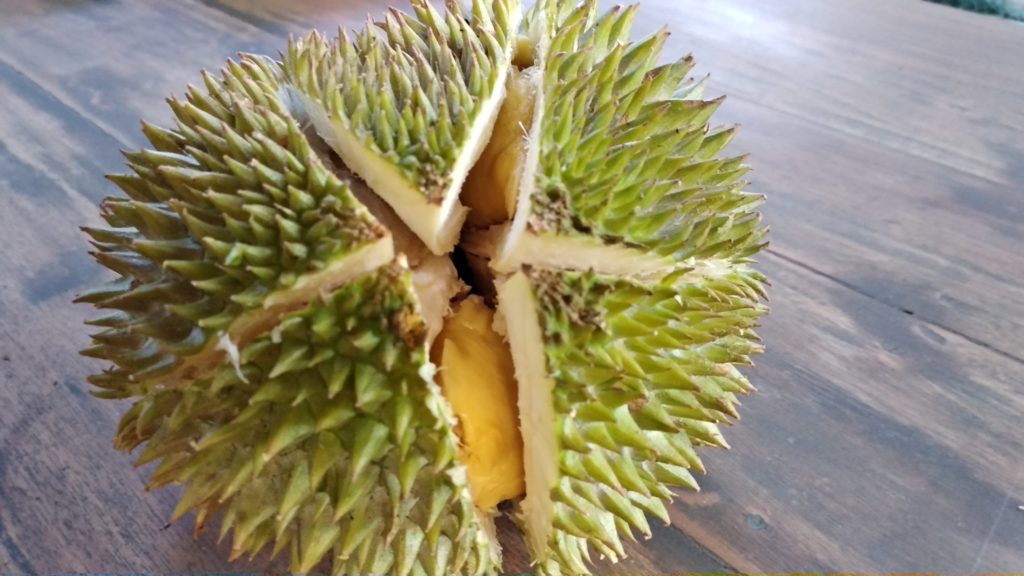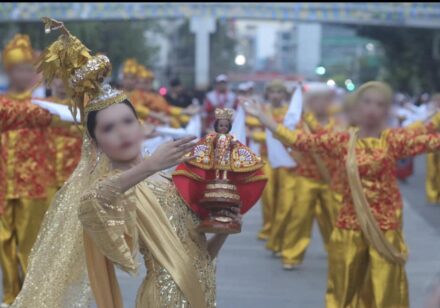
Eating durian to me has been an acquired taste. From my first bite of it, however, it has become my favorite since. Known as an aphrodisiac, the durian is among the most sought after fruit in Mindanao.
Cutting open the durian requires skill and many anecdotes have grown around it. One anecdote goes that anyone can remove the durian smell from his hands by washing them with water poured into its empty shells. And, yes, to better enjoy durian, you have to eat it with a bottle of Coke or a cup of coffee.
If one is warned that eating too much of the fruit will raise one’s blood pressure, another advises to wash with water the durian before eating it to help rid the body of toxins. Okay, whatever it is, there has yet to be scientific basis for all these claims.
Today’s focus is on Mindanao’s rich variety of fruits, photos of these are splashed in the internet, in newspapers and magazines to help celebrate Davao’s Kadayawan Festival this month. The public is likewise made aware of Mindanao’s surplus fruits in particular, the durian.
In Davao’s malls and other places, people are invited to ‘eat all you can’ for Php 25 to Php 99 for mangosteen, lanzones, rambutan and yes, the king of them all, the durian in many varieties competing for one’s attention.
From the shape, skin color of deep to light green, and distinctive marks on its thorny cover like that of a star, a connoisseur can tell the variety of the durian from its shape and color, and how it tastes within its cavernous interior – like golden custard, sweet and creamy but a bit bitter.
In Iligan, one can buy the malagkit, arancilyo, puyat, and imported varieties from Thailand all year.But, to many Mindanaoans, the umali variety from South Cotabato is the best, even as I’m not certain of the number of varieties in Mindanao.
Believe it or not, the fruit is so abundant in Mindanao that a downstream industry was born long ago, the most popular products carry the brand “Lola Abon’s”.
From durian flavored tarts, candies, hopia, pies, chips, cakes, coffee, smoothies or shakes, name it, the concoctions where the durian is folded into them is as varied and the creativity is limitless.
In Iligan, the best coffee durian can be had at the Resto-Bar Iliganon owned by the Alontos.
Other than food and beverage, crafts and souvenirs from the durian fruit or from its seeds and skins are made into key chains, table decorations and other products sold everywhere. Breeding and cross breeding durian to produce better varieties continue unabated today.
Durian is grown abundantly in Mindanao, Indonesia, Malaysia and in Thailand, where the number of varieties range from 100 to 300.
As a convert and a fan of this heavenly fruit, I then read about its botanical origins and with these, sure enough, I found legends about it.
Here, I will share two taken from my academic paper and a published article I had written for a national newspaper a few years ago.
Two versions of the legend
In Mindanao, there are two known versions of the “Legend of the Durian”. Both tales elicit the metaphor of love and how the two heroes in the tales differ in their quest for it and how love can be had out of great sacrifice, patience and determination and that only the gods know of its secret.

The first version is about vengeance and the lack of faith taking the best of the naturally imperious Datu. His wife, a snake in reality, left him and he was forced to rear his son, Duri alone.
This version expressly narrates two characteristics of tribal life where the Datu has absolute power over everyone and, vengeance for a dead or murdered parent or sibling is justified. As told, the Datu’s wife was a snake who took the form of a woman, danced before the Datu, making him marry her. This snake-woman did what she did to avenge her snake mother who was reportedly killed by the Datu.
The second version is from a retelling by Jesus Manuel Torrento published in the CCP’s Ani in 1990 which I , in turn, retell here. It is from the Bagobos of Mindanao and is the more beautiful since its setting describes an earthly paradise.
In this kingdom, all people lived long owing perhaps to the unpolluted environment. Most of all, Bagani (brave hero) became lonely for he had no wife nor children. At the age of 173, he fell in love with Madayaw-Bayhon, she who is beautiful of face. Her beauty was likened to bedewed flowers at dawn. She had long lashes and her lips were likened to ‘fire orchids’, and her skin was like ‘white sand bleached in the sun’ – the adjectives taken from the natural environment – quite refreshing and a rest from Western allusions.
Rich allusions from nature
This version from about the durian or ‘fruit of love’ is rich with allusions from nature. The setting was during a time of peace and plenty. When Bagani, leader of the Bagobos ate of the ‘odoriferous’ fruit became young again, his wife, Madayaw-Bayhon finally fell in love with him and rushed to him after her having taken a bite of the same fruit. This proves once more the belief that the durian is an aphrodisiac.
Such description of the manner in which the young wife ‘falls’ for the husband who has regained his youth after having a bite of the magical fruit suggests that the wife has become, akin to, what Sarah Blaffer Hrdy, as quoted by American writer Donna Harraway calls the “sexually interested” or “sexually receptive” [human] female in this case. The tale is in fact quite Asian too, with the emphasis on ‘face’ as significant in attracting any male, especially an alpha male with political power.
Mt. Apo
The setting of the tale is described as ‘a kingdom in Maguindanaw nestling like “a green gem” among the foothills of Mt. Apo, whose tall peak reaches “the very roots of heaven” – abode of Mandaragan, chief of the Bagobo gods”.
This suggests that the power of the tree comes from its support of “the very roots of heaven” like a powerful father of a family or the leader of a group holding up a naturally blessed kingdom. In other words, Mt. Apo is like the giant, powerful tree holding up the ‘very roots of heaven’ hence, the place is blessed by the gods.
Mt. Apo today has remained a mystery although many climbers have tried to conquer this mountain and often, in the process, a number would lose their lives. But there is no debate that in numerous Mindanao tales, the mountain is either a mystery or sacred. It has its own power and people attribute value to such a high mound where the clouds beyond the ridges often settle.
Bagani, brave hero, a conqueror
Bagani, a conqueror of many lands, ruled this most alluring of environments and people like him, were happy and contented. Based on the physical description of the narrative, it must have been an environment of plenty and pristine beauty which could explain Bagani’s not needing at first, a companion to be happy in an earthly paradise.
But Bagani did marry; however, every time the young wife would miss her father Kudehrat’s kingdom, she would leave Bagani’s kingdom without his permission. Kudehrat’s name in the narrative came as a surprise. Historically, Sultan Kudarat was the most powerful of all Maguindanaoans and adjacent regions during his lifetime.
In the legend, however, Bagani was more powerful, and Kudehrat the father, would sail and return his spoiled daughter Madayaw-Bayhon to Bagani. This happened often and Bagani grew tired of this and demanded a solution from his most ancient adviser, the 600-year old Tageb and his 15 other advisers, who were just as ancient. After much scolding, cursing and threats to his advisers, they finally told the Datu to see the 2,700-year old hermit, Matigam, who was half-mortal, half-god. His power was such that once he had transformed the proud princess of Daba-Daba into a Waring-Waring, a wild orchid known today as Waling-Waling, a much sought after expensive variety of orchid. The wise hermit prescribed three things for Bagani to gather: the egg from a black Tabon bird, milk from a white Carabao and nectar from the Tree of Make Believe hidden in the hair of the wood nymph.
Of course, with the help of the sea nymph, Punta Dumalag, Bagani was able to get the black Tabon’s egg from the navel of the sea; the milk from the white Carabao which his people had gathered; and, the nectar from the blossom of the Tree of Make Believe hidden in the hair of the wood-nymph through the help of her sister, Hangin-bai (Air nymph).
Bagani brought all the things to the wise hermit. The hermit cracked a portion of the black Tabon’s egg then poured the milk from the white Carabao and the nectar of the flower from the Tree of Make Believe. He then stirred the mixture inside the egg and returned the egg intact, to Bagani. The wise hermit instructed Bagani to plant the egg in the royal garden and asked that he be invited to the celebration only when Bagani’s plan turned successful.
Bagani followed all of the hermit’s instructions Everything turned out as Bagani had desired. A great feast was held. Bagani invited everyone but he forgot to invite the wise hermit, Matigam. In anger, Matigam transformed the fruit by having this covered with thorns and whoever will hold it will ‘spill his blood’ and, instead of the sweet scent, he said ‘whoever eats them will foul his breath’.
Since then, the ‘magic fruit’ or durian, full of thorns, has turned ‘odoriferous’ as the punishment of Bagani’s lack of gratitude to the being who had helped him.
comments are temporarily disabled.













